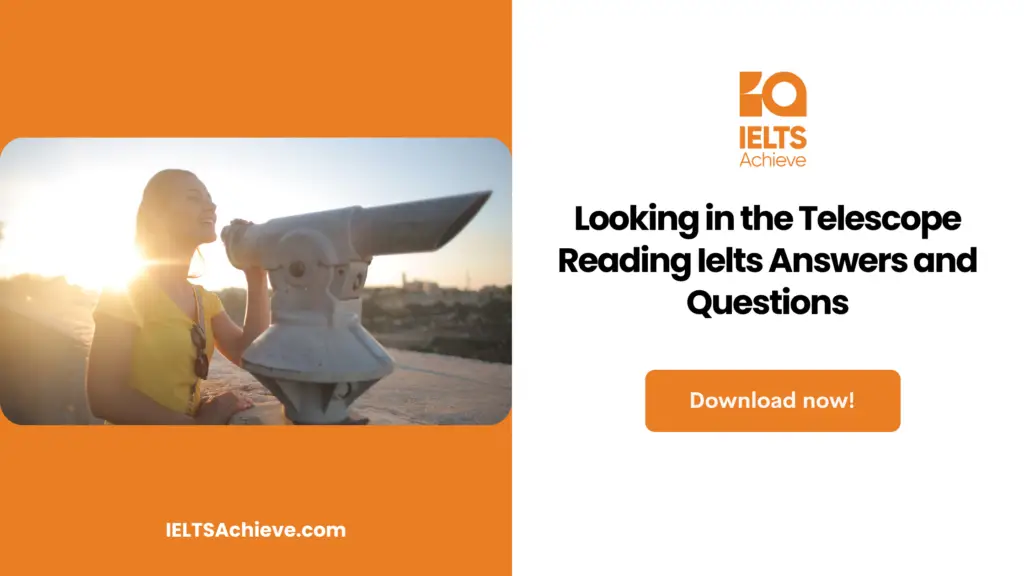The Blog post contains the following IELTS Reading Questions:
- IELTS Reading Summary Completion
- IELTS Reading Multiple Choice Questions
- IELTS Reading Matching Features
Stay informed and prepared for success – Explore our comprehensive Reading Test Info page to get valuable insights, exam format details, and expert tips for mastering the IELTS Reading section.
IELTS Reading Passage – Looking in the Telescope

Looking in the Telescope
A story is told that around 400 years ago some children were fooling around in an eye glass shop.They noticed that when they placed lenses one on top of the other, they were able to see a considerable distance. They played around with the concept for a while, experimenting with what happened when they varied the distance between the lenses. Hans Lippershey, the Dutch lens maker who eventually applied for the first telescope patent, credits children as having been his motivation for the invention of the first telescope.
The first telescopes built in the early 1600s were very primitive inventions allowing the user to see around 3-times further than the naked eye. It was not too long however, until Italian astronomer Galileo heard about the invention ‘that through use of correctly-positioned lenses, allowed people to see things a long way away’. The tools used in the manufacturing of the first refracting telescope was all Galileo needed to know and within 24 hours he had developed a better one. In fact, the process of improvements Galileo made on Lippershey’s telescope were quite dramatic. Whereas the original version had a magnification of 3, the new telescope had a magnification of around 30. Galileo achieved these extraordinary results by figuring out the combination of the positions of the lenses and also by making his own lenses which were of better quality. Although he originally thought they were stars, the better quality lenses – and some scientific analysis – enabled him to eventually use his telescopes to see the moons of Jupiter. Galileo’s refracting telescopes – so-called due to the way they handled the light that passed through them – were the standard at that time.
Some 70 years later, British scientist Isaac Newton, explored the way a prism refracts 1 white light into an array of colors. He recognised that a lens was a circular prism and that the separation of colors limited the effectiveness of the telescopes in use at the time. Newton created a Reflective Telescope, one that used a dish-shaped or parabolic mirror to collect light and concentrate the image before it was visible in the eyepiece. Thus, lenses used for magnification in telescopes were replaced by mirrors. Mirrors have since been the standard for telescopes. In fact, according to telescope researcher Dr. Carl Addams, the basic designs of telescopes have not changed much in the last 100 years. What has changed however, is the way technology has been used to improve them. For example, the larger telescopes in the world today are around 10 metres in diameter and the mirrors placed within them are so finely polished that even at the microscopic level there are no scratches or bumps on them at all. To achieve such a flawless surface requires a very expensive process that operates with the utmost precision.
1: The separation or change of direction of a ray of light when passed through a glass of water.
The mid 1700s, saw the discovery and production of the Achromatic telescope. This type of telescope differed from previous ones in the way it handled the different wavelengths of light.The first person who succeeded in making achromatic refracting telescopes seems to have been the Englishman, Chester Moore Hall. The telescope design used two pieces of special optical glass known as crown and flint. Each side of each piece was ground and polished and then the two pieces were assembled together. Achromatic lenses bring two wavelengths – typically red and blue – into focus in the same plane. Makers of achromatic telescopes had difficulty locating disks of flint glass of suitable purity needed to construct them. In the late 1700s, prizes were offered by the French Academy of Sciences for any chemist or glass-manufacturer that could create perfect discs of optical flint glass; however, no one was able to provide a large disk of suitable purity and clarity.
Currently the largest telescopes are around eight to ten metres in size. These extremely expensive and sophisticated pieces of equipment are located primarily throughout Europe and America. Dr Addams believes that the telescopes of the future will be a gigantic improvement in what is currently considered state-of-the-art. Telescopes that are 20 or 30 metres in diameter are currently being planned, and there has been a suggestion put forward by a European firm that they would like to build a 100-metre telescope. Says Addams, ‘The quality of the glass needed to build a 100 meter telescope is like building a lens the size of a football field and having the largest bump in that football field being a ten-thousandth of a human hair’. The engineering and technology required to build such a flawless reflective surface is most impressive.
Unlock your full potential in the IELTS Reading section – Visit our IELTS Reading Practice Question Answer page now!
Recommended Questions:
Renewable Energy IELTS Reading Question with Answer
Looking in the Telescope – Reading Questions
Questions 1-5
Choose the correct letter, A, B, C or D.
Write the correct letter in boxes 1-5 on your answer sheet.
1) According to the writer, the first telescope was
A. invented by children.
B. made by a lens maker.
C. a reflective telescope.
D. quite a complex piece of equipment.
2) The writer states that Galileo
A. improved on the design of the first telescope.
B. created the first reflective telescope.
C. took 24 hours to make a reflective telescope.
D. allowed people to see 3 times further than the first telescope.
3) The Galileo telescope was better than the first telescope because it
A. used mirrors rather than glass.
B. was longer than the first telescope.
C. used better lens positioning and quality.
D. used better quality lenses and glass.
4) The writer states that today large telescopes are
A. 20 or 30 metres in size.
B. as big as 100 metres.
C. very costly items.
D. as good as will ever be built.
5) Large, powerful telescopes are difficult to build because
A. designs have not changed in nearly 100 years.
B. it is difficult to locate the flint glass needed for them.
C. the area needed to house the telescope is simply too large.
D. the lenses must be extremely reflective.
Ready to improve your performance in Multiple Choice Questions (MCQs)? Click here to access our comprehensive guide on how to tackle MCQs effectively in the IELTS Reading section.
Questions 6 – 10
Classify the following features as belonging to
A. the Achromatic telescope
B. the Reflective telescope
C. the Refracting telescope
Write the correct letter A, B or C in boxes 6-10 on your answer sheet.
6) The first telescopes made.
7) Uses a series of lenses one on top of the other.
8) Highly polished lenses.
9) First use of mirrors to collect light.
10) Two pieces of glass stuck together.
Improve your performance in Matching Features questions by clicking here to access our comprehensive guide. Learn how to match specific features or characteristics with the options provided in the IELTS Reading section.
Questions 11-13
Complete the summary below using words from the passage.
Choose NO MORE THAN THREE WORDS from the passage for each answer.
Write your answers in boxes 11-13 on your answer sheet
There have been a number of changes in telescopes since they were first invented. For example, Galileo’s telescope increased magnification of the previously made telescope by a factor of 30. He did this by altering the lenses 11) _______________ and also constructing lenses 12) ______________. Other improvements followed but the most significant step forward, and still a major factor today in telescope design, has been the inclusion of 13) _______________.
Boost your performance in Summary, Notes, Table, and Flowchart Completion tasks. Click here to explore our detailed guide and learn how to effectively complete summaries, notes, tables, and flowcharts in the IELTS Reading section.
Unlock your full potential in the IELTS Reading section – Visit our IELTS Reading Practice Question Answer page now!
Recommended Questions:
Renewable Energy IELTS Reading Question with Answer
Looking in the Telescope IELTS reading answer
1. B
2. A
3. C
4. C
5. D
6. C
7. C
8. A
9. B
10. A
11. positions
12. of better quality
13. mirrors

We hope you found this post useful in helping you to study for the IELTS Test. If you have any questions please let us know in the comments below or on the Facebook page.
The best way to keep up to date with posts like this is to like us on Facebook, then follow us on Instagram and Pinterest. If you need help preparing for the IELTS Test, join the IELTS Achieve Academy and see how we can assist you to achieve your desired band score. We offer an essay correction service, mock exams and online courses.

